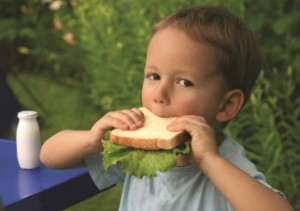Gag reflex is an automatic reaction of the body that helps prevent choking. Children have a gag reflex when the back of the tongue is touched to prevent toddlers from consuming something that could cause them harm. As you introduce solid foods to your toddler, you will have to be cautious about introducing combination baby foods containing meat and vegetable bits.
What Causes This Problem?
Toddlers might gag on something they should not have in their mouths (e.g. toy parts, sequins, buttons, etc.). They might also choke if they eat too fast, have too much food in their mouths or if they do not like the taste or texture of the food they are eating (lumpy foods such as hot dogs, gummy candies, caramel, meat, nuts, popcorn, fruits with seeds and cheese).
Toddlers with chewing and swallowing problems or those who have delays in their motor skills can also experience gagging.
How You Can Help
Help Your Toddler Relax
Encourage your little one to relax during meals. Do not let him play, run around, walk or jump while he is still chewing his food. Do not try to feed him more than he is inclined to. Talk to your toddler about a fun encounter, how his day went, what he did and so on. Play soothing music. Eat beside your toddler. A calm and comfortable eating environment will help your toddler eat slowly.
Add Texture To Your Toddler’s Food
As much as possible, avoid buying store-bought food. Prepare his food yourself so you can control the texture of the food. You can do this by adding graham crackers or wheat germ into your toddler’s smooth food. This will make the food less smooth, but there will be no surprise chunks. Start off slowly, and as your toddler gets used to the new texture, you can add more. This will help your toddler get slowly accustomed to the feeling of texture in his mouth and throat.
Encourage Self-feeding
If your toddler is capable, allow him to feed himself. Children with sensitive gags often do better if they eat on their own. Just teach your toddler to pick up one piece of food at a time and to carefully chew and swallow before placing another piece of food into his mouth.
Play Games That Decrease Oral Sensitivities
If your toddler has no physical problems with the mouth or throat yet constantly gags, there are things you can do to help him adjust. Play face-touching games using a Koosh ball, stuffed toy or warm washcloth. Have him bite on chew toys (teething toys with bumps and different textures). Let him touch your face and guide his hands to the different parts of his body as well. This way, you introduce your toddler to endure facials sensations and make a positive association.
Seek Medical Help
Getting a medical evaluation can resolve this problem. Your toddler’s doctor can check for any physical problems (e.g. esophagus is too narrow or does not function efficiently). If there is a physical problem, the pediatrician can refer you to a feeding specialist who will come up with an individualized program to help reduce your toddler’s gag reflex or your child may need to take medications and undergo therapies.
Gagging is only temporary. It will take time, but with patience and ingenuity, you can help your toddler learn to tolerate textured foods more easily.





